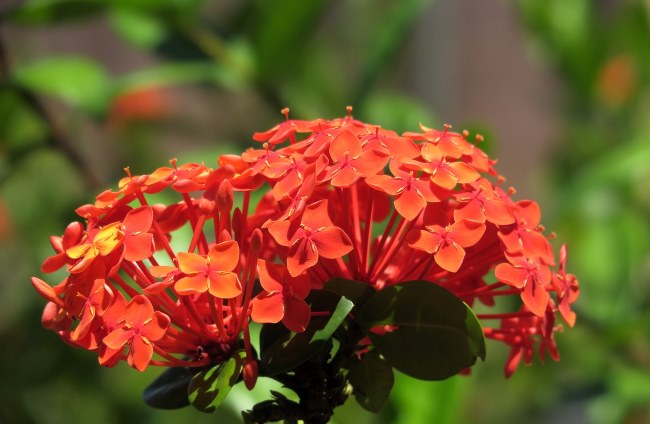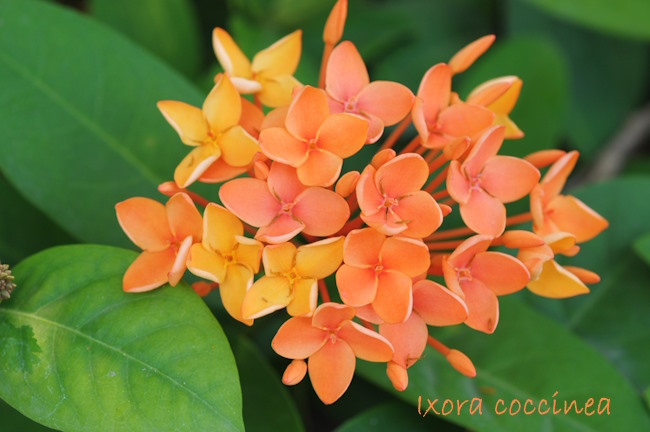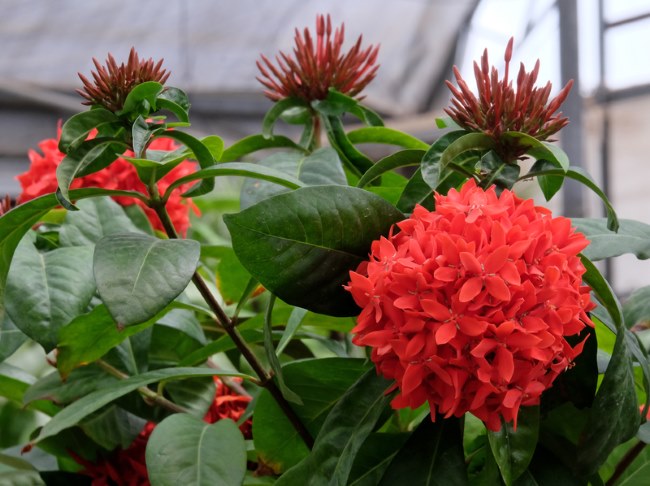Ixora Coccinea Care
Botanical Name: Ixora coccinea
Big, bright flower clusters give this gorgeous tropical shrub a couple common names: Flame-of-the-Woods and Jungle Geranium.
Discover how to grow Ixoras in containers, find out how much sunshine and water they want year-round, when to repot, and how to make these beauties bloom. (It's easy!)
 Clusters of vibrant blooms make Ixora a sought-after tropical plant.
Clusters of vibrant blooms make Ixora a sought-after tropical plant.Get to Know Ixora Coccinea
This magnificent perennial prefers sunshine, warm temps and high humidity, like in its native tropical habitat of India and Sri Lanka.
Now you can find cultivars available with blooms in shades of pinks, yellows, oranges and reds. Each star-like flower has 4 petals and can grow up to 1-in (2.5 cm) wide. Not that impressive, but put dozens of blooms together and those flower heads pack a lot of sizzling color on this compact shrub.
Even young plants are eager to bloom. You won't wait long for barely rooted cuttings to flower.
Many Ixora flowers are also delightfully fragrant, attracting butterflies if you choose to move your plant to the patio for the summer.
Glossy, oval leaves grow in opposite pairs on upright stems. Prune Ixora coccinea back after flowering is over to keep it compact. Shrubs that aren't pruned will look leggy and may need staking.
How big do Ixoras get? These woody shrubs will eventually reach 2-4 ft tall, and spread about as wide, so they need some room. Look for dwarf varieties -- they grow up to 2 ft (30 cm) and are ideal for growing in small containers.
We are Family
Ixora is a genus in the Rubiaceae family, that spans about 600 species of shrubs, trees and herbs. Coffea and gardenia are in this family of wonderfully scented plants.
 Photo credit istockphoto.com
Photo credit istockphoto.comHow to Make Ixora Coccinea Flower and Other Special Helps
No blooms? Ixoras that don't bloom aren't getting enough light. Put it in a warm greenhouse or sunroom to give your plant the sunlight it wants. Depending on where you live, moving Ixora coccinea to your patio for the summer may be ideal.
Deadhead spent blooms for a better looking plant and to encourage more flowers.
Fertilize I. coccinea during the growing season to give it more blooming power. (See "Fertilizer" below.)
Repot in spring, moving up 1 pot size to give this beautiful flowering plant more room to grow. Use a pot with drainage holes to prevent soggy soil.
Overwinter Ixora indoors. This perennial evergreen doesn't like the cold at all. If you set your potted shrub outside for the summer, bring it in when the temperature drops below 60°F/16°C at night. This sudden change to low light levels will be a shock to the plant and it will likely drop a lot of leaves. Don't worry, it's normal. Reduce watering and stop fertilizing till spring.
Something bugging your plant? Not many pests will bother Ixora indoors, but watch for aphids and scale insects that like to nibble on new plant growth. Treat an infested plant right away to prevent damage, and to keep pests from moving on to nearby plants.
 Gorgeous Ixora flowerheads blooming in greenhouse. Photo ©Irina Opachevsky
Gorgeous Ixora flowerheads blooming in greenhouse. Photo ©Irina OpachevskyIxora Coccinea Plant Care
Light: Full sun to partial shade. Ixora coccinea needs plenty of direct sunlight to bloom. Scoot your plant outdoors for the summer, if you want, to give it the light it needs.
Water: Water thoroughly then allow the surface of the potting medium to dry out before watering again. Don't allow it to dry out too much -- Ixora will wilt and not bloom well if the potting mix is dry. Use rainwater, allowing it to warm up to room-temperature because cold water will shock this tropical native. Water less in winter, when growth slows.
Humidity: High humidity is a must. If relative humidity drops below 50%, place pot on a tray of wet pebbles or use a cool-mist room humidifier for Ixoras. If the leaf edges turn brown and flower buds shrivel without opening, the air is too dry.
Temperature: Keep warm year-round (75°F/24°C) with a minimum temperature of 60°F/16°C. Remember, this warm-natured, evergreen shrub doesn't like the cold. Protect plant from cold blasts from windows, entry ways and A/C vents.
Soil: Acidic peat moss-based mix, such as African violet potting mix.
Fertilizer: Feed every 2 weeks in spring and summer with an all-purpose water-soluble fertilizer diluted by half.
Propagation: Take 3-inch (8 cm) stem tip cuttings in spring or summer. Dip the cut end in water, then hormone rooting powder. Put the stem in moist potting mix, then firm the mix around the stem so that it stands up. Enclose the whole pot in plastic to maintain humidity. Roots should develop in about a month.


